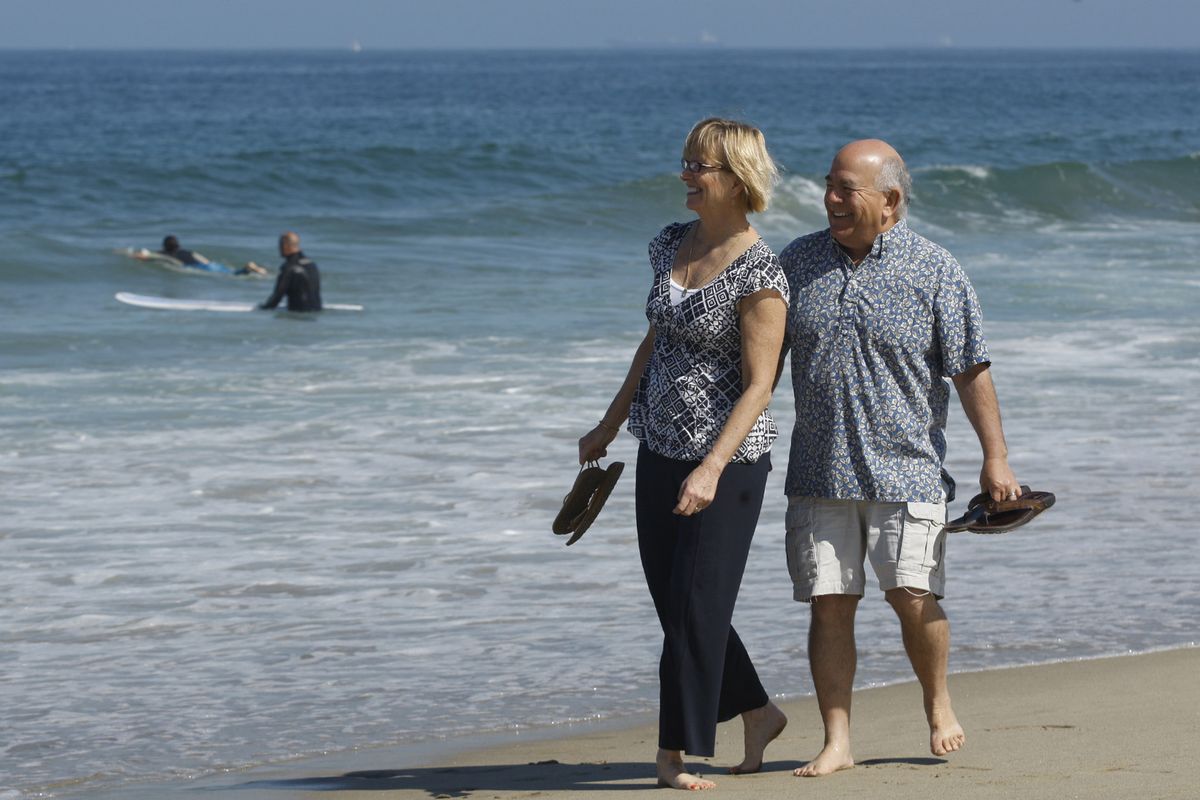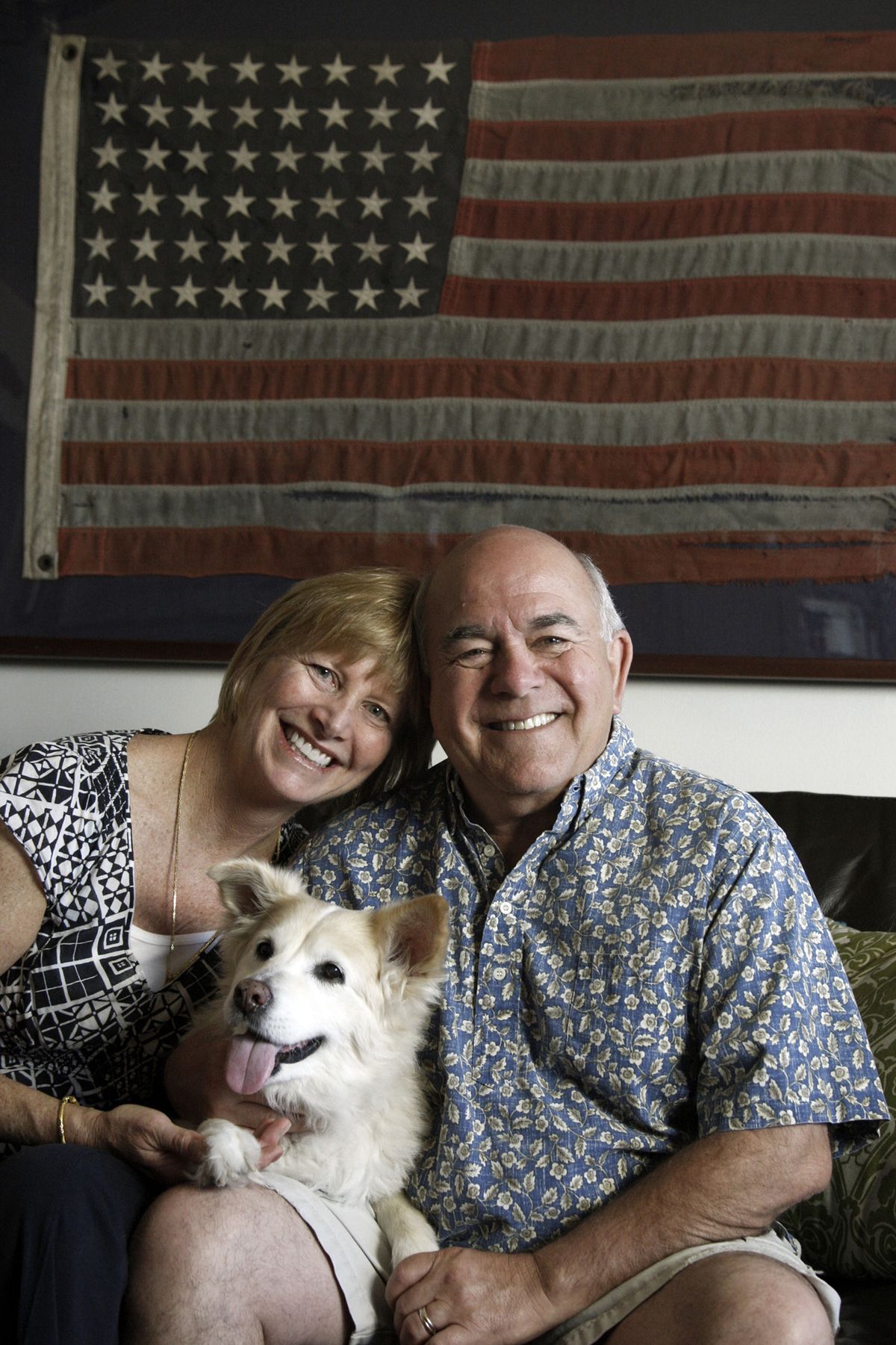Financial security doesn’t necessarily pair with peace of mind
Susie Martin, 54, and Patrick Webster, 63, walk barefoot in the sand near their home in Redondo Beach, Calif., on May 13.
Call it retirement anxiety, or maybe recession obsession.
For all of their married life, Patrick Webster, 63, and Susie Martin, 54, have been extremely frugal.
Webster and Martin, who both work at Marymount College in Rancho Palos Verdes, Calif., have been stashing away their combined income at an enviable rate – more than 25 percent – for retirement.
Together they have more than $1 million in investments and no debt. But rather than feeling reasonably secure about their financial future, they dread a return of hard times.
“I wanted to be a multimillionaire and retire at 54, but everything crashed,” Webster said of one of the four stock market downturns he has endured, that one in 1990 while he was teaching in Texas. “I lost my job, lost my house. I lost everything.”
“My horizon is no longer 25 years,” he said. “If we have another stock market crash and the Dow goes back down to 6,000, I don’t have the time to recover. I would have to work until I die, and I don’t want to do that.”
Certified financial planner Delia Fernandez, who reviewed the couple’s financial situation, said that feeling of vulnerability is common among baby boomers, who have had their confidence rocked by the volatility of the stock market.
“A lot of younger people don’t realize what the baby boomers have been through,” Fernandez said. “The fact that the market has come back every time is small comfort.”
Stock market contractions have not only come more frequently since 1990, they have been progressively worse each time, she said.
There was a roughly 15 percent decline from June to November of 1990, then a 15 percent drop in July-August 1998. Next was the long bear market that ran from September 2000 to September 2002, when the market fell nearly 45 percent. The worst was a 51 percent decline between November 2007 and February 2009.
Webster and Martin’s response was to spend as little as possible and save as much as they could to get back into a better financial position.
Like a lot of baby boomers who saw the value of their investments erode in the last recession, Webster expects the worst.
“Something is going to happen in the next five years” to the U.S. economy, he said, “and we need to be better prepared for it.”
How have they prepared so far?
“We don’t go to Starbucks every day. No manicures, no pedicures. Those kinds of things really add up,” Martin said.
Webster’s response was to work more like someone who was earning only a minimal wage. Even though he was making $80,000 annually working as a full-time math professor at Marymount College – with Martin adding her $70,000-a-year salary as an articulation officer, who provides educational and vocational guidance services – Webster held a second job for 18 years.
After a couple of hours at his Redondo Beach, Calif., home, Webster hit the road again at 5 p.m. in his aged Corvette, off to teach a three-hour class at El Camino College in Torrance, Calif., for an additional $20,000 a year. Sometimes he taught on weekends too.
This past semester was the first he hasn’t worked a second job. “It felt so weird to me, like I was a slacker,” said Webster, who was only half-joking when he added, “I feel like I’m in semi-retirement right now because I’m only working one job.”
Martin has maintained her distance from the family finances, preferring to let her husband crunch the numbers. After opening her retirement accounts, she pretty much ignored where her investments were going.
Webster and Martin got married in 1997 in Ireland, in a small town where his great-grandparents lived.
A romantic evening for the couple is a candlelight dinner at home.
Even their vacations are thrifty. When they go overseas, which they like to do twice a year, there are no four-star hotels or expensive restaurants. They eat in the places that are popular with the locals. Sitting free at a park, for Webster, is better than a museum.
But even though they spend as little as possible and have a high savings rate, they knew very little about whether their investments were right for their age range.
Nor was Webster confident about the way he would respond if the stock market suddenly took a turn for the worse.
“I really become frozen when it comes to selling stocks and reinvesting,” Webster said, adding that this was “one reason I lost $100,000 in the dot-com boom and bust.”
Fee-only financial planner Fernandez, founder of Fernandez Financial Advisory in Los Alamitos, Calif., commended the couple’s robust ability to save money.
Her two-hour meeting with Webster and Martin was part pep talk and part trip to the principal’s office.
Unlike the typical investor in their age ranges, Webster and Martin had a very risky reliance on stocks of about 85 percent. That could be disastrous in the event of another stock market crash.
“You have the portfolio of a 20-year-old,” Fernandez chided. In other words, someone who had 40 years or more of retirement savings ahead of them could afford to take high risks, but people of Webster’s and Martin’s ages should be more conservative with their investments.
Still, Fernandez didn’t want the couple to suddenly move a huge amount out of their stock funds.
“We don’t want to move everything in one fell swoop, in case the stock market still has room to grow,” Fernandez explained.
She told the couple to put all new investment money into more conservative funds, not just in their employers’ retirement accounts but also their Roth IRAs and a separate taxable Vanguard investment account.
“This is also how we change course, by putting the next investment dollars into something new,” Fernandez said.
To address the stock over-investment concern, Fernandez had the couple shift 20 percent of the riskier holdings on the equities side of their Teachers Insurance and Annuity Association “into something really boring.” That 20 percent went into the TIAA’s traditional annuity account, which has returned an average of 4.77 percent during the last five years.
For the Vanguard taxable account, Fernandez suggested putting all new money into funds with a lower concentration of stocks and a higher percentage of other investments.
Fernandez told the couple that their goal should be to reduce their reliance on stock funds to between 60 percent and 65 percent of their retirement savings.
That percentage target would have been lower had there not been a nine-year age difference between Webster and Martin.
Fernandez also showed the couple that Webster could retire as early as 65, even though he still has plans to work until 70.
Fernandez even factored in the possibility of four years of expensive long-term care. It barely made a dent in the couple’s newly reformatted investment outlook.
The shift in the atmosphere of the room was palpable. Martin, who had put distance between herself and the couple’s investments, was suddenly taking copious notes.
Webster shifted from a slight slouch in his chair to the front edge of his seat, his back suddenly straighter. He actually began to smile.
“I don’t have to work two jobs again,” he said.
But perhaps his follow-up email to Fernandez put it best.
“Your analysis,” Webster wrote, “has given me a great deal of peace.”

